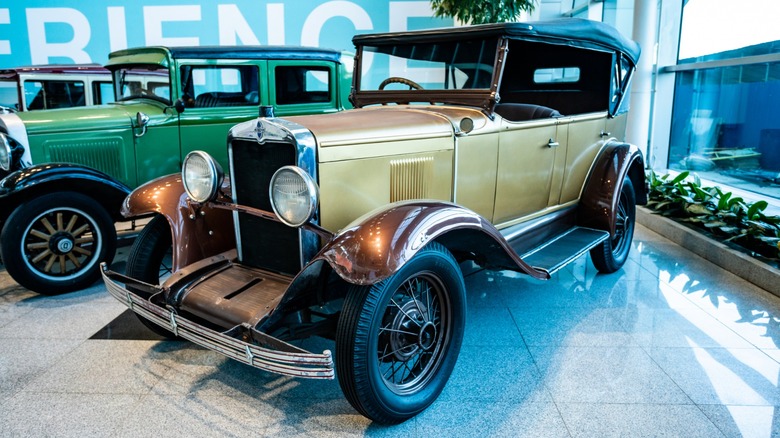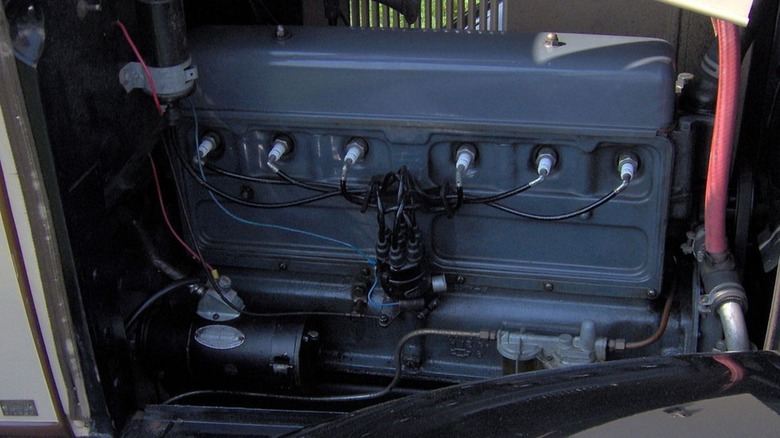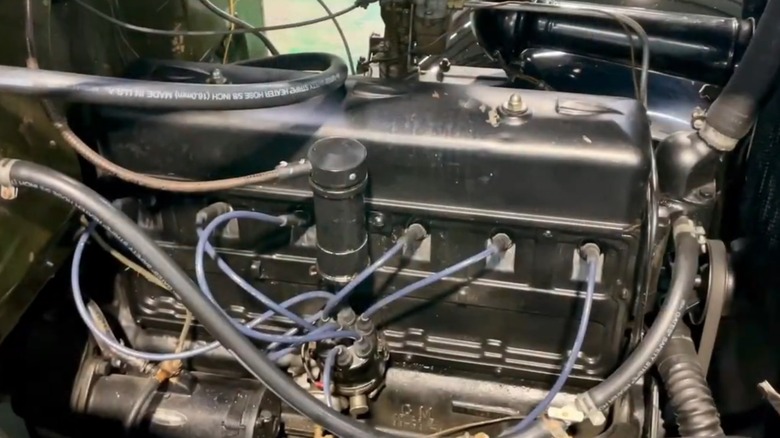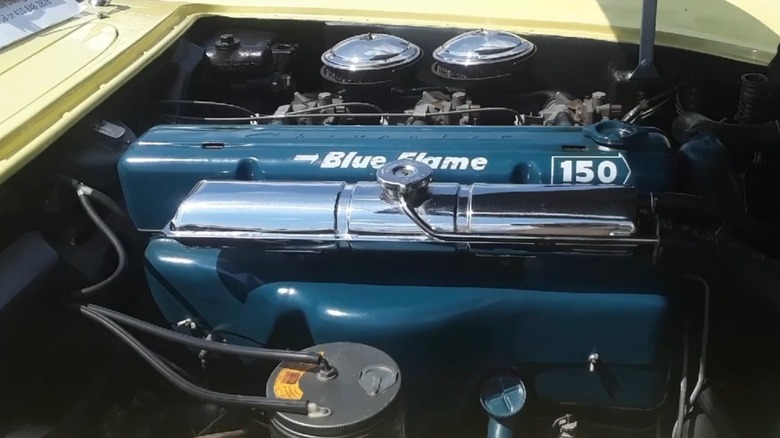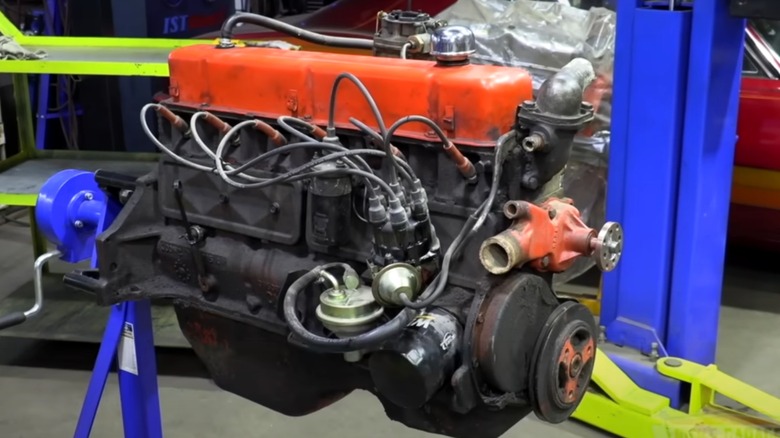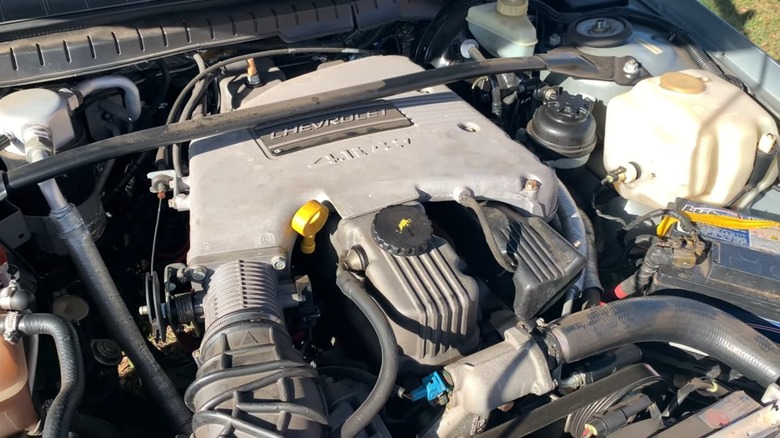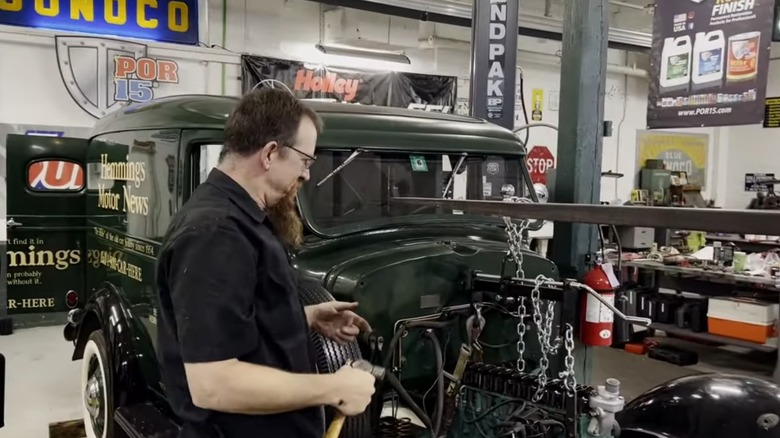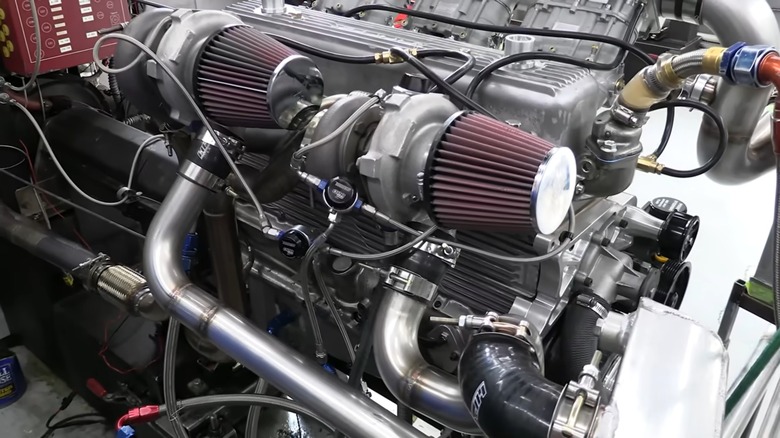Everything Chevy Fans Should Know About The Stovebolt Engine
Automaker Chevrolet is a legendary company responsible for some of the most popular vehicles ever made. The Corvette is a sports car legend, while the Chevelle reigns as the king of muscle cars. Meanwhile, the backbone carrying the weight of working America is the Chevrolet Silverado pickup. All of Chevy's iconic vehicles have been powered by what have been equally iconic power plants, including the small-block Chevy V8, the LS V8, and even the mighty 454 V8. However, these legendary V8s are all predated by an engine with an enduring legacy that may surprise even ardent Chevy fanatics, the Stovebolt Six.
Straight-six engines powered Chevrolet's first cars.The Series C Classic Six was a big 299 cubic-inch unit powering a limited production car from a company in its infancy, but it was too expensive and only lasted until 1914. As the company moved under the General Motors umbrella as the low-cost leader, its cars were all powered by a more economical four-cylinder. That changed in 1929 with the introduction of an all-new six-cylinder, which the company would put in cars advertised as being equipped with "a six for the price of a four." It was a smart move, as that engine powered millions of Chevrolets. It gained a nickname early on, the Stovebolt Six, and here are some things Chevy fans should know about it.
What is a Stovebolt?
You can easily tell that the names of most engines are creations of the manufacturers, such as the Oldsmobile Rocket 88 V8 engine, which began powering Oldsmobiles in the 1950s. Even though there's no actual rocket associated with that engine, the name is still pretty cool. More recently, Chrysler released the 1,000-horsepower Helephant, and Ford has the 5.2-liter Voodoo for its Mustangs. These are obviously cool names geared for marketing, but you may be asking yourself just what exactly is a Stovebolt?
The Stovebolt moniker was never given to the engine via official channels. Introduced in 1929, the all-new Chevrolet six-cylinder engine replaced its four-cylinder engines across all Chevrolet models. People began calling it Stovebolt for the external fasteners used on the side of the engine that looked much like the bolts used to assemble wood-burning stoves at the time, hence the name Stovebolt. Stove bolts look like machine screws but have thicker and coarser threads that give them the bolt designation. The nickname was used so much, it kind of just stuck and continues to be used today.
[Featured image by Stephen Foskett via Wikimedia Commons | Cropped and scaled | CC BY-SA 3.0]
A Chevrolet engine for all
In the early days, Chevrolet only produced a handful of cars and trucks, with many components common throughout the lineup. Comprehensive histories from the early period of Chevrolet are not as ubiquitous as those for the same era of Ford, and details of the lineup and operations remain scarce. However, from looking through the cars produced by Chevrolet at the time, few differences can be found based on outward appearance, and all of them used the same four-cylinder engine, including trucks. However, there was one exception, the innovative Copper-Cooled Chevrolet that failed so badly production was halted with just 500 cars built.
When the new six-cylinder engine arrived, it replaced the four-cylinder in its entirety and became Chevrolet's standard engine for all models. Wanting to differentiate itself from its main competitor, Ford, Chevrolet advertised its "six for the price of a four" against Ford models in the same price range.
Blue Flame
For the 1937 model year, Chevrolet released its first update to the popular Stovebolt. This second-generation engine received an official designation from Chevy, Blue Flame. While it sounds like a cool name dreamed up by marketing guys sitting at drafting tables, it comes from the engineering side of things at the company. Blue Flame is a reference to the flame produced when an engine achieves the "perfect combustion."
While the original Stovebolt provided three main bearings for the crankshaft and relied on splash lubrication for the rod bearings, the Blue Flame received an additional main bearing with a revised oiling system that squirted a stream of oil onto the connecting rods for more complete lubrication. Furthermore, in 1929, the base 194 Stovebolt produced just 50 horsepower, and the new Blue Flame base engine increased to 216 cubic inches and an output of 85 horsepower, a significant improvement.
Throughout this period, Chevrolet used the same engine for all models of both car and truck. Although they came with a range of power and torque, the most exciting application was the Blue Flame six-cylinder of the debut 1953 Corvette. Engineers reworked the engine with several modifications, and with a trio of carburetors bolted to its side, the new sports car came with 150 horsepower and a top speed of 108 mph. It was quickly replaced with a new V8, which has made Blue Flame Corvettes skyrocket in value today.
Modernization
By 1962, the Stovebolt name had fallen out of use, but the fundamentals of the engine remained. For generation three, Chevrolet updated the Blue Flame iteration of the Stovebolt to match technology emerging in contemporary engines. It received additional main bearings, providing support for another increase in power, reliability, and the circular combustion chamber was altered to a wedge shape, resulting in more complete combustion and better efficiency.
Throughout the '60s and '70s, a Chevy six of multiple displacements could be found across a wide range of GM vehicles in everything from the Nova and Chevelle to Pickups and Pontiacs. In this era, cars received the Hi-thrift 120, Super-Thrift 153, or Turbo-Thrift 230 versions of this engine while pickup options were the Thriftmaster 235 or Jobmaster 261, although applications that demanded more pull received the High Torque 292. A 250 cubic-inch version arrived in 1966 and remained the most common automobile application until the end of its production.
Chevrolet introduced its first V6 in 1978, spelling doom for the old Stovebolt-derived six-cylinder. The base engineering had become a bit long in the tooth and automobile technology was rapidly advancing. Nonetheless, trucks continued to be produced in the U.S. until 1989, while foreign production continued for many years later.
Tuned by Lotus
Although Chevrolet in North America had moved on to increase its V6 engines across the lineup by the 1990s, GM Brazil continued to use the Turbo-Thrift 250, although that name no longer called it. Brazil had been producing Chevrolet models locally for decades, with many models either developed for the market or adapted for the market from mostly European models. This meant that the oversized American models with huge gas-guzzling V8 engines were never on offer, and the Chevy six was a mainstay of its engine offerings.
For Brazilian hot rodders of the '70s, the Opala SS was the car to have, and its 169-horsepower Turbo-thrift made it a competitive racer. That engine continued to be the hot performer in the '90s when they took the 4.1-liter block to Lotus to have it tuned for a new high-output Omega, an Opel model built in Brazil. Lotus developed a dual-overhead cam head for the engine, but GM Brazil declined to use that in favor of having the overhead-valve head reworked for better performance at a lower cost. While the fuel-injected dual-cam version from Lotus could have provided 250+ horsepower, the production version yielded 168, remaining in production until 1998.
A loyal following
Any brief search of the small-block Chevy V8 on the internet will reveal page after page of results with specialty websites, custom parts stores, and multiple forums just for this one engine often dedicated to a single displacement, such as the 350 or 400. While the results are nowhere near as numerous, you might be surprised to see what a search for the old Stovebolt might yield.
Despite being a basic engine at first, with later iterations serving as base model options, plenty of enthusiasts are keeping these things alive. Furthermore, they fall into several camps, from those rebuilding them for classic restorations, often done with period correct precision, to others taking one or another variation of Stovebolt to modify, often with incredibly clever methods.
Stovebolt.com contains a wealth of information, including technical articles, feature stories, contributor photos, and a discussion forum with nearly 40,000 members. Serving those members and more is Langdon's Stovebolt 6, specializing in used Stovebolt parts. Additionally, 12bolt.com is a much more sophisticated outfit with a robust catalog with a wide range of reproduction and aftermarket parts. Discussion forums such as Inliners International exist as a dedicated forum for these fans, while sub-boards of classic car sites also serve the Stovebolt. In March, 2024, Hemmings posted on Jalopy Journal seeking advice for an engine swap on the publication's '36 panel truck, receiving dozens of user recommendations, many of which were useful. Anyone wanting to take on a Stovebolt project will not be without resources still today.
Stovebolt potential
Seeing a lovingly restored classic Chevy brought back to its original condition is always exciting — at least for certain people. The dedication and skill in recreating a 70 or 80-year-old car like new can be simply stunning. However, equally impressive is how some people take old miserly engines like the Stovebolt and modify them beyond what anyone ever thought possible.
It takes dedication and passion to build what many might consider to be an inferior engine to be able to compete with most V8 models. That is exactly what Inliners International member Tom Lowe has done for years, squeezing 300 horsepower out of turbocharged Turbo-Thrift 250 engines. According to Motor Trend, he has more than 30 years of experience with these engines and fabricates many parts used in his builds featured on 12bolt.com.
While Lowe's builds are impressive, someone whose sanity may be in question built a Stovebolt with modern Corvette power. YouTuber The Horsepower Monster recorded this engine, which uses a block and crankshaft from the early 1950s topped by a reproduction racing cylinder head installed along with twin turbos and a custom intake featuring six individual throttle bodies and Holley fuel injection. The outcome of this extensive modification is beyond impressive, and its cost was surely excessive. On the engine stand, dyno readings hit 525 horsepower, although the builder speculates additional tuning could raise that to 750, an impressive feat for an engine beginning life with just 50.
